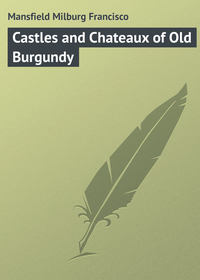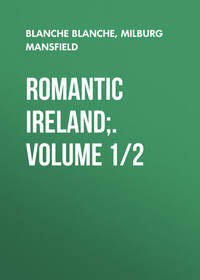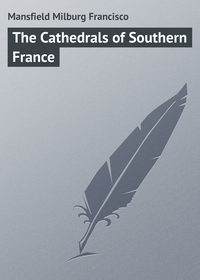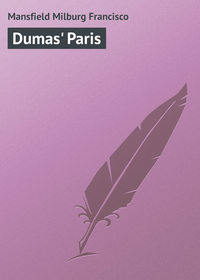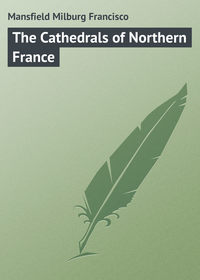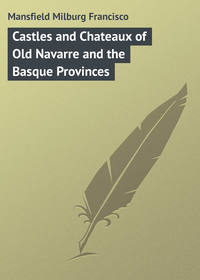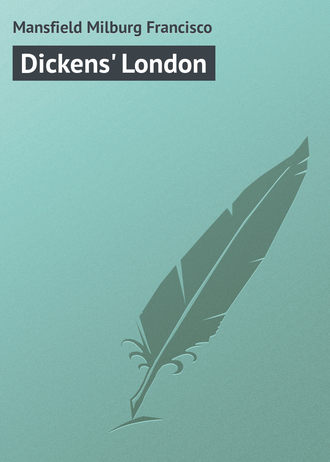 полная версия
полная версияDickens' London
Ram Alley and Pye Corner were here in Alsatia, the former a passage between the Temple and Sergeant's Inn, which existed until recently.
Mitre Court is perhaps the most famous and revered of all the purlieus of Fleet Street. "The Mitre Tavern," or rather a reminiscence of it, much frequented by the London journalist of to-day and of Dickens' time, still occupies the site of a former structure which has long since disappeared, where Johnson used to drink his port, and where he made his famous remark to Ogilvie with regard to the noble prospects of Scotland: "I believe, sir, you have a great many … but, sir, let me tell you the noblest prospect which a Scotchman ever sees is the highroad that leads him to England."
Of all the old array of taverns of Fleet Street, "The Cock" most recently retained a semblance, at least, of its former characteristics, which recalls one of Tennyson's early poems, "A Monologue of Will Waterproof," which has truly immortalized this house of refreshment:
"Thou plump head-waiter at the CockTo which I most resort,How goes the time? Is't nine o'clock?Then fetch a pint of port."Salisbury Court, or Salisbury Square as it has now become, is another of those literary suburbs of Fleet Street – if one may so call it – where modern literature was fostered and has prospered. It occupies the courtyard of Salisbury or Dorset House. Betterton, Cave, and Sandford, the actors, lived here; Shadwell, Lady Davenant, the widow of the laureate; Dryden and Richardson also. Indeed Richardson wrote "Pamela" here, and Goldsmith was his "press corrector."
DICKENS' CONTEMPORARIES
When Scott was at the height of his popularity and reputation, cultivated and imaginative prose was but another expression of the older poesy. But within twenty-five years of Scott's concluding fictions, Dickens and Thackeray, and still later, George Eliot and Kingsley, had come into the mart with an entirely new brand of wares, a development unknown to Scott, and of a tendency which was to popularize literature far more than the most sanguine hopes of even Scott's own ambition.
There was more warmth, geniality, and general good feeling expressed in the printed page, and the people – that vast public which must ever make or mar literary reputations, if they are to be financially successful ones, which, after all, is the standard by which most reputations are valued – were ready and willing to support what was popularly supposed to stand for the spread of culture.
Biographers and critics have been wont to attribute this wide love for literature to the influence of Scott. Admirable enough this influence was, to be sure, and the fact is that since his time books have been more pleasingly frank, candid, and generous. But it was not until Dickens appeared, with his almost immediate and phenomenal success, that the real rage for the novel took form.
The first magazine, The Gentleman's, and the first review, The Edinburgh, were contemporary with Scott's productions, and grew up quite independently, of course, but their development was supposed, rightly or wrongly, to be coincident with the influences which were set in motion by the publication of Scott's novels. Certainly they were sent broadcast, and their influence was widespread, likewise Scott's devotees, but his books were "hard reading" for the masses nevertheless, and his most ardent champion could hardly claim for him a tithe of the popularity which came so suddenly to Charles Dickens.
"Pickwick Papers" (1837) appeared only six years later than Scott's last works, and but eight years before Thackeray's "Vanity Fair." It was, however, a thing apart from either, with the defects and merits of its author's own peculiar and energetic style.
Jealousies and bickerings there doubtless were, in those days, as ever, among literary folk, but though there may have been many who were envious, few were impolite or unjust enough not to recognize the new expression which had come among them. One can well infer this by recalling the fact that Thackeray himself, at a Royal Academy banquet, had said that he was fearful of what "Pickwick's" reputation might have been had he succeeded in getting the commission, afterward given to Seymour, to illustrate the articles.
There appears to have been, at one time, some misunderstanding between Dickens and his publishers as to who really was responsible for the birth of "Pickwick," one claim having been made that Dickens was only commissioned to write up Seymour's drawings. This Dickens disclaimed emphatically in the preface written to a later edition, citing the fact that Seymour only contributed the few drawings to the first serial part, unfortunately dying before any others were even put in hand.
There is apparently some discrepancy between the varying accounts of this incident, but Dickens probably had the right of it, though the idea of some sort of a "Nimrod Club," which afterward took Dickens' form in the "Pickwickians," was thought of between his publishers and Seymour. In fact, among others, besides Dickens, who were considered as being able to do the text, were Theodore Hook, Leigh Hunt, and Tom Hood.
As originally planned, it was undoubtedly a piece of what is contemptuously known as hack work. What it afterward became, under Dickens' masterful power, all the parties concerned, and the world in general, know full well.
The statement that Dickens is "out of date," "not read now," or is "too verbose," is by the mark when his work is compared with that of his contemporaries. In a comparative manner he is probably very much read, and very well read, too, for that matter. Far more so, doubtless, than most of his contemporaries; certainly before George Eliot, Wilkie Collins, Bulwer, or even Carlyle or Thackeray.
The very best evidence of this, if it is needed, is to recall to what great extent familiarity with the works of Dickens has crept into the daily life of "the people," who more than ever form the great majority of readers.
True, times and tastes have changed from even a quarter of a century ago. Fashions come and go with literature, novels in particular, as with all else, and the works of Dickens, as a steady fare, would probably pall on the most enthusiastic of his admirers. On the other hand, he would be a dull person indeed who could see no humour in "Pickwick," whatever his age, creed, or condition.
Admirers of the great novelist have been well looked after in respect to editions of his works. New ones follow each other nowadays in an extraordinarily rapid succession, and no series of classics makes its appearance without at least three or four of Dickens' works finding places in its list.
In England alone there have been twenty-four complete copyright editions, from "the cheap edition," first put upon the market in 1847, to the dainty and charming India paper edition printed at the Oxford University Press in 1901.
"In the Athenæum Club," says Mr. Percy Fitzgerald, "where many a pleasant tradition is preserved, we may see at a window a table facing the United Service Club at which Dickens was fond of having his lunch… In the hall by the coats (after their Garrick quarrel), Dickens and Thackeray met, shortly before the latter's death. A moment's hesitation, and Thackeray put out his hand … and they were reconciled."
It has been said, and justly, that Thackeray – Dickens' contemporary, not rival – had little of the topographical instinct which led to no small degree of Dickens' fame. It has, too, been further claimed that Thackeray was in debt to Dickens for having borrowed such expressions as "the opposite side of Goswell Street was over the way." And such suggestions as the "Two jackals of Lord Steyne and Mess. Wegg and Wenham, reminiscent of Pike and Pluck, and Sedley's native servant, who was supposed to have descended from Bagstock's menial." Much more of the same sort might be recounted, all of which, if it is true, is perhaps no sin, but rather a compliment.
The relics and remains of Dickens exist to a remarkable degree of numbers. As is well known, the omnific American collector is yearly, nay daily, acquiring many of those treasures of literature and art which the old world has treasured for generations; to the gratification of himself and the pride of his country, though, be it said, to the disconcern of the Briton.
The American, according to his English cousin, it seems, has a pronounced taste for acquiring the rarest of Dickens' books, and the choicest of Dickens' holographs, and his most personal relics.
The committee of the "Dickens Fellowship," a newly founded institution to perpetuate the novelist's name and fame, recently sought to bring together in an exhibition held in Memorial Hall, London, as many of those souvenirs as possible; and a very attractive and interesting show it proved to be.
The catalogue of this exhibition, however, had tacked on to it this significant note: "The Committee's quest for literary memorabilia of the immortal 'Boz' indicates the distressing fact that many of the rarest items are lost to us for ever."
All of which goes again to show that the great interest of Americans in the subject is, in a way, the excuse for being of this monograph on London during the life and times of Dickens.
Various exhibitions of Dickens' manuscripts have been publicly held in London from time to time, at The Exhibition of the Works of the English Humourists in 1889, at the Victorian Exhibition of 1897, and the British Museum has generally on show, in the "King's Library," a manuscript or two of the novels; there are many more always to be seen in the "Dyce and Forster Collection" at South Kensington. Never, before the exhibition held in 1902 by the "Dickens Fellowship," has there been one absolutely restricted to Dickens.
It is, of course, impossible to enumerate the various items, and it would not be meet that the attempt should be made here. It will be enough to say that among the many interesting numbers was the first portion of an unpublished travesty on "Othello," written in 1833, before the first published "Boz" sketch, and a hitherto unknown (to experts) page of "Pickwick," this one fragment being valued, says the catalogue, at £150 sterling. First editions, portraits, oil paintings, miniatures, and what not, and autographs were here in great numbers, presentation copies of Dickens' books, given to his friends, and autographs and portraits of his contemporaries, as well as the original sketches of illustrations to the various works by Seymour, "Phiz," Cruikshank, Stone, Leech, Barnard, and Pailthorpe, not forgetting a reference to the excellent work of our own Darley, and latterly Charles Dana Gibson.
Among the most interesting items of contemporary interest in this exhibition, which may be classed as unique, were presentation copies of the novels made to friends and acquaintances by Dickens himself.
Among them were "David Copperfield," a presentation copy to the Hon. Mrs. Percy Fitzgerald; "Oliver Twist," with the following inscription on the title-page, "From George Cruikshank to H. W. Brunton, March 19, 1872;" "A Child's History of England," with an autograph letter to Marcus Stone, R. A.; "A Tale of Two Cities," presented to Mrs. Macready, with autograph; "The Chimes" (Christmas Book, 1845), containing a unique impression of Leech's illustration thereto.
Other interesting and valuable ana were the Visitors' Book of "Watts' Charity," at Rochester, containing the signatures of "C. D." and Mark Lemon; the quill pen belonging to Charles Dickens, and used by him just previous to his death; a paper-knife formerly belonging to "C. D.," and the writing-desk used by "C. D." on his last American tour; silver wassail-bowl and stand presented to "C. D." by members of the Philosophical Institution of Edinburgh in 1858; walking-stick formerly belonging to "C. D.;" a screen belonging to Moses Pickwick, of Bath – the veritable Moses Pickwick of Chap. XXXV. of "Pickwick Papers;" the oak balustrade from the old "White Hart" (pulled down in 1889); pewter tankards from various of the Pickwickian Inns; the entrance door of Newgate Prison, of which mention is made in "Barnaby Rudge," Chap. LXIV.; warrant officer's staff, formerly in use in the Marshalsea Prison; original sign of "The Little Wooden Midshipman" ("Dombey and Son"), formerly over the doorway of Messrs. Norie and Wilson, the nautical publishers in the Minories. This varied collection, of which the above is only a mere selection, together with such minor personalia as had been preserved by friends and members of the family, formed a highly interesting collection of Dickens' reliques, and one whose like will hardly be got together again.
Innumerable portraits, photographs, lithographs, and drawings of the novelist were included, as well as of his friends and contemporaries.
Letters and documents referring to Dickens' relations with Shirley Brooks, Richard Bentley, Hablôt K. Browne, Frederic Chapman, J. P. Harley, Mark Lemon, Samuel Rogers, Newby, John Forster, David Maclise, and many others, mostly unpublished, were shown, and should form a valuable fund of material for a biographer, should he be inclined to add to Dickens' literature of the day, and could he but have access to and the privilege of reprinting them.
A word on the beginnings of what is commonly called serial literature is pertinent to the subject. The first publication with which Dickens' identity was solely connected was the issue of "Pickwick" in monthly parts in 1836-37.
A literary critic, writing in 1849, had this to say on the matter in general, with a further reference to the appearance of "David Copperfield," whose author was the chief and founder of the serial novel:
"The small library which issues from the press on the first of every month is a new and increasing fashion in literature, which carves out works into slices and serves them up in fresh portions twelve times in the year. Prose and poetry, original and selected, translations and republications, of every class and character, are included. The mere enumeration of titles would require a vast space, and any attempt to analyze the contents, or to estimate the influence which the class exerts upon the literary taste of the day would expand into a volume of itself. As an event of importance must be mentioned the appearance of the first number of a new story, 'David Copperfield,' by Charles Dickens. His rival humourist, Mr. Thackeray, has finished one and begun another of his domestic histories within the twelve-month, his new story, 'Pendennis,' having journeyed seven-twentieths of the way to completion. Mr. Lever rides double with 'Roland Cashel' and 'Con Cregan,' making their punctual appearance upon the appointed days. Of another order is Mr. Jerrold's 'Man Made of Money.' Incidents are of little consequence to this author, except by way of pegs to hang reflections and conclusions upon.
"Passing over the long list of magazines and reviews as belonging to another class of publication, there is a numerous series of reprints, new editions, etc., issued in monthly parts, and generally in a cheap and compendious form. Shakespeare and Byron among the poets, Bulwer, Dickens, and James among the novelists, appear pretty regularly, – the poets being enriched with notes and illustrations. Other writers and miscellaneous novels find republication in the 'Parlour Library of Fiction,' with so rigid an application of economy that for two shillings we may purchase a guinea and a half's worth of the most popular romances at the original price of publication. Besides the works of imagination, and above them in value, stand Knight's series of 'Monthly Volumes,' Murray's 'Home and Colonial Library,' and the 'Scientific' and 'Literary Libraries' of Mr. Bohn. The contents of these collections are very diversified; many volumes are altogether original, and others are new translations of foreign works, or modernized versions of antiquarian authors. A large mass of the most valuable works contained in our literature may be found in Mr. Bohn's 'Library.' The class of publications introduced in them all partakes but little of the serial character. It is only the form of their appearance which gives them a place among the periodicals."
In the light of more recent events and tendencies, this appears to have been the first serious attempt to popularize and broaden the sale of literature to any considerable extent, and it may be justly inferred that the cheap "Libraries," "Series," and "Reprints" of the present day are but an outgrowth therefrom.
As for Dickens' own share in this development, it is only necessary to recall the demand which has for many years existed for the original issues of such of the novels as appeared in parts. The earliest issues were: "The Pickwick Papers," in 20 parts, 1836-37, which contained the two suppressed Buss plates; "Nicholas Nickleby," in 20 parts, 1838-39; "Master Humphrey's Clock," in 88 weekly numbers, 1840-41; "Master Humphrey's Clock," in 20 monthly parts, 1840-41; "Martin Chuzzlewit," in 20 parts, 1843-44; "Oliver Twist," in 10 octavo parts, 1846.
At the time when "Oliver Twist" had scarce begun, Dickens was already surrounded by a large circle of literary and artistic friends and acquaintances. His head might well have been turned by his financial success, many another might have been so affected. His income at this time (1837-38) was supposed to have increased from £400 to £2,000 per annum, surely an independent position, were it an assured one for any litterateur of even the first rank, of Dickens' day or of any other.
In November of 1837 "Pickwick" was finished, and the event celebrated by a dinner "at the Prince of Wales" in Leicester Place, off Leicester Square. To this function Dickens had invited Talfourd, Forster, Macready, Harrison Ainsworth, Jerdan, Edward Chapman, and William Hall.
Dickens' letter to Macready was in part as follows:
"It is to celebrate (that is too great a word, but I can think of no better) the conclusion of my 'Pickwick' labours; and so I intend, before you take that roll upon the grass you spoke of, to beg your acceptance of one of the first complete copies of the work. I shall be much delighted if you would join us."
Of "Nicholas Nickleby," written in 1838-39, Sydney Smith, one of its many detractors, finally succumbed and admitted: "'Nickleby' is very good – I held out against Dickens as long as I could, but he has conquered me."
Shortly after the "Pickwick" dinner, and after the death of his wife's sister Mary, who lived with them, Dickens, his wife, and "Phiz," – Hablôt K. Browne, – the illustrator of "Pickwick," journeyed together abroad for a brief time. On his return, Dickens first made acquaintance with the seaside village of Broadstairs, where his memory still lives, preserved by an ungainly structure yclept "Bleak House."
It may be permissible here to make further mention of Broadstairs. The town itself formed the subject of a paper which he wrote for Household Words in 1851, while as to the structure known as "Bleak House," it formed, as beforesaid, his residence for a short time in 1843.
Writing to an American friend, Professor Felton, at that time, he said:
"In a bay-window in a 'one pair' sits, from nine o'clock to one, a gentleman with rather long hair and no neckcloth, who writes and grins as if he thought he were very funny indeed. His name is Boz… He is brown as a berry, and they do say is a small fortune to the innkeeper who sells beer and cold punch…"
Altogether a unique and impressive pen-portrait, and being from the hand of one who knew his sitter, should be considered a truthful one.
In 1843 Maclise made that remarkable and winsome pencil sketch of Dickens, his wife, and her sister Georgina, one of those fleeting impressions which, for depicting character and sentiment, is worth square yards of conventional portraiture, and which is reproduced here out of sheer admiration for its beauty and power as a record intime. It has been rather coarsely referred to in the past as Maclise's sketch of "Dickens and his pair of petticoats," but we let that pass by virtue of its own sweeping condemnation, – of its being anything more than a charming and intimate record of a fleeting period in the novelist's life, too soon to go – never to return.
Dickens' connection with the Daily News was but of brief duration; true, his partisans have tried to prove that it was under his leadership that it was launched upon its career. This is true in a measure, – he was its first editor, – but his tenure of office only lasted "three short weeks."
He was succeeded in the editorial chair by his biographer, Forster.
The first number came out on January 21, 1846, – a copy in the recent "Dickens Fellowship Exhibition" (London. 1903) bore the following inscription in Mrs. Dickens' autograph: "Brought home by Charles at two o'clock in the morning. – Catherine Dickens. January 21." Thus it is that each issue of a great newspaper is born, or made, though the use of the midnight oil which was burned on this occasion was no novelty to Charles Dickens himself. The issue in question contained the first of a series of "Travelling Sketches – Written on the Road," which were afterward published in book form as "Pictures from Italy."
A unique circumstance of contemporary interest to Americans occurred during Dickens' second visit to America (1868) in "The Great International Walking Match." A London bookseller at the present time (1903) has in his possession the original agreement between George Dolby (British subject), alias "The Man of Ross," and James Ripley Osgood, alias "The Boston Bantam," wherein Charles Dickens, described as "The Gad's Hill Gasper," is made umpire.
One of the most famous and interesting portraits of Dickens was that made in pencil by Sir John Millais, A. R. A., in 1870. This was the last presentment of the novelist, in fact, a posthumous portrait, and its reproduction was for a long time not permitted. The original hangs in the parlour of "The Leather Bottle," at Cobham, given to the present proprietor by the Rev. A. H. Berger, M. A., Vicar of Cobham. Among other famous portraits of Dickens were those by Ary Scheffer, 1856; a miniature on ivory by Mrs. Barrow, 1830; a pencil study by "Phiz," 1837; a chalk drawing by Samuel Lawrence, 1838; "The Captain Boabdil" portrait by Leslie, 1846; an oil portrait by W. P. Frith, R. A., 1859; a pastel portrait by J. G. Gersterhauer, 1861; and a chalk drawing by E. G. Lewis, 1869. This list forms a chronology of the more important items of Dickens portraiture from the earliest to that taken after his death, subsequent to which was made a plaster cast, from which Thomas Woolner, R. A., modelled the bust portrait.
The "Boz Club," founded in 1899 by Mr. Percy Fitzgerald, one of Dickens' "bright young men" in association with him in the conduct of Household Words was originally composed of members of the Athenæum Club, of whom the following knew Dickens personally, Lord James of Hereford, Mr. Marcus Stone, R. A., and Mr. Luke Fildes, R. A., who, with others, foregathered for the purpose of dining together and keeping green the memory of the novelist.
Its membership has since been extended to embrace the following gentlemen, who also had the pleasure and gratification of acquaintanceship with Dickens: the Marquis of Dufferin and Ava (since died), Lord Brompton, Hamilton Aide, Alfred Austin, Sir Squire Bancroft, Arthur à Beckett, Francesco Berger, Henry Fielding Dickens, K. C., Edward Dicy, C. B., W. P. Frith, R. A., William Farrow, Otto Goldschmidt, John Hollingshead, the Very Reverend Dean Hole, Sir Henry Irving, Frederick A. Inderwick, K. C., Sir Herbert Jerningham, K. C., M. G., Charles Kent, Fred'k G. Kitton, Moy Thomas, Right Honourable Sir Arthur Otway, Bart., Joseph C. Parkinson, George Storey, A. R. A., J. Ashby Sterry, and Right Honourable Sir H. Drummond Wolfe.
Perhaps the most whole-souled endorsement of the esteem with which Dickens was held among his friends and contemporaries was contributed to the special Dickens' memorial number of Household Words by Francesco Berger, who composed the incidental music which accompanied Wilkie Collins' play, "The Frozen Deep," in which Dickens himself appeared in 1857:
"I saw a great deal of Charles Dickens personally for many years. He was always most genial and most hearty, a man whose friendship was of the warmest possible character, and who put his whole soul into every pursuit. He was most generous, and his household was conducted on a very liberal scale.




